Buffy Pipit
A species of Pipits Scientific name : Anthus vaalensis Genus : Pipits
Buffy Pipit, A species of Pipits
Botanical name: Anthus vaalensis
Genus: Pipits
Content
Description General Info
Description
Its length is 16–18 cm (6.3–7.1 in), and its weight is 23–36.6 g (0.81–1.29 oz). It is often confused with the plain-backed pipit because both species have plain upperparts. The upperparts of the buffy pipit are paler and buffier than the plain-backed pipit. The buffy pipit has a pale supercilium, and its lower mandible has a pinkish base. It has faint markings on the breast, and the belly and flanks are buffy. The juvenile has mottles. 
Size
19 cm
Nest Placement
Ground
Feeding Habits
Buffy Pipit subsists primarily on a varied diet of insects like beetles, grasshoppers, ants, termites, and caterpillars, with seeds also consumed. It forages on the ground through walking, showing a unique prey preference among ground-dwelling birds.
Habitat
The buffy Pipit inhabits open grasslands, often characterized by overgrazed patches and bare ground. It is also associated with fallow lands, recently burnt areas, and pan peripheries. Occasionally, the buffy Pipit can be found in clearings within open woodlands. It is adapted to relatively drier environments compared to its sympatric relatives, occupying broadly distributed grassland ecosystems.
Dite type
Insectivorous
General Info
Feeding Habits
Bird food type
Behavior
One or two individuals are usually encountered, but flocks may be found in winter. It frequently wags its tail. Its song is a repeated tchreep-churup, and the call sshik is given when the bird is flushed. It eats invertebrates and seeds. Breeding has been recorded from July to February in Zimbabwe and August to December in South Africa. The nest is an open cup built on the ground. 
Distribution Area
The buffy pipit is found in Angola, Botswana, Democratic Republic of the Congo, Malawi, Mozambique, Namibia, South Africa, Swaziland, Tanzania, Zambia, and Zimbabwe, with a distribution size estimated at 5,660,000 km (2,190,000 sq mi). Its habitat is semi-arid plains with grasses and bare ground. It also occurs in pastures, burnt fields, and edges of saltpans. 
Species Status
The population size is not known. The species has an increasing population trend and a large range, so the IUCN Red List has assessed the species as least concern. 
